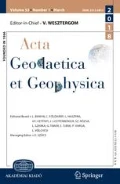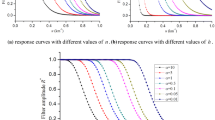Abstract
Gravity gradient tensor downward continuation can highlight the anomaly characteristics of the shallow, reflect the characteristics of abnormal body horizontal density variation. Nowadays, most gradient tensor downward continuation studies are focusing on spatial domain, and the current obstacles are slow computation speed and small downward continuation height in frequency domain research. In this study, we showed a new method to downward continuation of gravity gradient data using Taylor iteration method. The general Taylor iteration method formula was deduced, and we proved the convergence of the approach. Modeling experiment showed a good fit to large point spacing. The analysis of the iterations radio showed that the Taylor expansion item is correlated with convergence speed. Furthermore, the application to the actual data of America Vinton, LA demonstrated that Taylor iteration method has a good effect to actual data.








Similar content being viewed by others
References
Drinkwater MR, Haagmans R, Muzi D et al (2007) The GOCE gravity mission. In: ESA’s first core earth explorer, proceedings of 3rd international GOCE user workshop, 6–8 November, 2006, Frascati, Italy, ESA SP-627, ISBN 92-9092-938, pp 1–8
Fedi M, Florio G (2002) A stable downward continuation by using the ISVD method. Geophys J Int 151:146–156
Guan ZN, Hao TZ, Yao CL (2002) Prospect of gravity and magnetic exploration in the 21st century. Progr Geophys 17(2):237–244 (in Chinese)
Janak Juraj, Fukuda Yoichi, Peiliang Xu (2009) Application of GOCE for regional gravity field modeling. Earth Planets Space 61:835–843
Jiang FY, Xue J, Gao LK, Huang LY (2013) The continuation of the gravity gradient tensor. Comput Tech Geophys Geochem Explor 35(1):112–122 (in Chinese)
Klees R, Koop R, Visser P, van den Ijssel J (2000) Efficient gravity field recovery from GOCE gravity gradient observations. J Geod 74:561–571
Liu XG, Wang K (2012) Downward continuation of satellite gravity gradient data based on Poisson integral iteration method. Procedia Environ Sci 12:721–728
Liu XG, Li SS, Wu X (2011) Downward continuation of satellite gravity gradient data. J Geod Geodyn 31(1):132–137 (in Chinese)
Pail R, Fecher T, Bruinsma S et al (2011) First GOCE gravity field models derived by three different approaches. J Geod 85:819–843
Robert T, Pavel N (2013) Effect of crustal density structures on GOCE gravity gradient observables. Terr Atmos Ocean Sci 24(5):793–807
Strakhov AV, Devisyn VN (1965) The reduction of observed values of a potential field to values at a constant level. Akad. NauK UssR Izv. Fiziki Zemli 4:256–261
Sun WK (2002) Satellite in low orbit (CHAMP, GRACE, GOCE) and high precision earth gravity field- the latest progress of satellite gravity geodesy and its great influence on geosciences. J Geod Geodyn 22(1):92–100 (in Chinese)
Wang YG, Zhang FX, Wang ZW, Meng LS, Zhang J (2011) Taylor series iteration downward continuation of potential fields. Oil Geophys Prospect 46(4):657–662 (in Chinese)
Wang YG, Zhang FX, Wang ZW, Meng LS, Zhang J, Tai ZH (2012) Derivative-iteration method for downward continuation of potential fields. J Jilin Univ (Earth Sci Ed) 42(1):240–245 (in Chinese)
Xu PL (1992) Determination of surface gravity anomalies using gradiometric observables. Geophys J Int 110:321–332
Xu PL (1998) Truncated SVD methods for discrete linear ill-posed problems. Geophys J Int 135:505–514
Xu SZ (2006) The integral-iteration method for continuation of potential fields. Chin J Geophys 49(4):1176–1182 (in Chinese)
Xu SZ (2007) A comparison of effects between the iteration method and FFT for downward continuation of potential fields. Chin J Geophys 50(1):285–289 (in Chinese)
Xu PL (2009) Iterative generalized cross-validation for fusing heteroscedastic data of inverse ill-posed problems. Geophys J Int 179:182–200
Xu SZ, Yu HL (2007) The interpolation-iteration method for potential field continuation from undulating surface to plane. Chin J Geophys 50(6):1811–1815 (in Chinese)
Xue QF (1978) Potential theory. Geological Publishing House, Beijing, pp 40–65 (in Chinese)
Zheng W, Xu HZ, Zhong M et al (2010) Study progress in international satellite gravity gradiometry programs. Sci Surv Mapp 35(2):57–61 (in Chinese)
Acknowledgments
This work is partially supported by Chinese National high technology research and development (963 program) Projects Nos. 2014AA06A613. We gratefully acknowledge Bell Geospace for providing the gravity gradient tensor data measured by Air-FTG in the Vinton Dome and for allowing publication of the data.
Author information
Authors and Affiliations
Corresponding author
Rights and permissions
About this article
Cite this article
Tang, S., Huang, D. Taylor iteration downward continuation method for gravity gradient tensor data. Acta Geod Geophys 51, 435–449 (2016). https://doi.org/10.1007/s40328-015-0135-3
Received:
Accepted:
Published:
Issue Date:
DOI: https://doi.org/10.1007/s40328-015-0135-3




